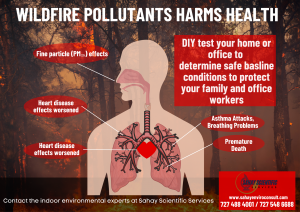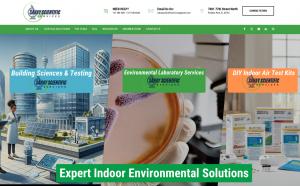Indoor Air Quality (IAQ) Considerations from Wildfire Smoke
As communities face both physical destruction and hidden environmental hazards, it is vital to prioritize clean air for overall health and well-being.”
LOS ANGELES, CA, UNITED STATES, January 14, 2025 /EINPresswire.com/ -- As wildfires become increasingly prevalent, it is vital to understand the hidden risks they pose to indoor air quality. Sahay Scientific Services emphasizes that maintaining access to clean air is essential for overall health. Unfortunately, wildfires introduce numerous harmful pollutants into the environment, creating risks that can linger long after the flames are extinguished.— Dr. Rajiv Sahay, FIAS, CIAQP
Understanding Wildfire Smoke Composition
Wildfire smoke is not merely an unpleasant odor but a complex mixture of hazardous pollutants. Key components include:
- PM2.5 (fine particulate matter): These microscopic particles can penetrate deep into the lungs and may even enter the bloodstream.
- Carbon monoxide: This colorless, odorless gas poses serious health risks when inhaled.
- Volatile organic compounds (VOCs): These chemicals can exacerbate air pollution and negatively impact health.
- Microbial pollutants: Wildfire smoke carries an array of microbes, including bacteria and fungi, known as "bioaerosols," which can travel long distances and affect health.
The composition of smoke can vary depending on the materials burned and the intensity of the fire, highlighting the need for thorough environmental testing.
Health Effects Associated with Wildfire Smoke Air Quality
The aftermath of wildfires can lead to significant health complications. Common health risks include:
- Respiratory illnesses: Smoke exposure can aggravate asthma and bronchitis.
- Cardiovascular issues: Prolonged exposure can strain the heart and blood vessels.
- Vulnerable populations: Children, seniors, and individuals with pre-existing health conditions are at greater risk for severe effects.
Common symptoms of exposure include coughing, mucus production, wheezing, and shortness of breath. Protecting these vulnerable groups is vital, especially during periods of poor air quality.
The Process of Air Quality Testing Post-Wildfire
Testing air quality is essential for recovery. Residents can gauge pollutants through:
- Professional testing: Experts use advanced equipment for accurate results.
- Do-it-yourself testing: Individuals can collect samples and send them to a lab for analysis.
Understanding the results and familiarizing oneself with safety thresholds is crucial to determine whether action is needed.
Mitigating Risks and Protecting Your Health
Improving indoor air quality after a wildfire is critical. Recommended steps include:
- Using air filtration systems: HEPA filters effectively capture harmful particles.
- Sealing entry points: Ensure windows and doors are closed to prevent smoke from entering.
- Ventilating cautiously: Open windows to refresh indoor air only if local air quality permits.
Sahay Scientific Services is dedicated to helping communities navigate these challenges. For expert air quality management, testing guidance, or media interviews, please contact us at 1-727-488-4001 or sahayscientificservices@gmail.com.
About Sahay Scientific Services
Sahay Scientific Services LLC specializes in environmental microbiology, focusing on Indoor Air Quality (IAQ) and health assessments. We assist individuals and organizations in creating safer environments through comprehensive ecological sampling and laboratory testing.
Dr. Rajiv Sahay, FIAS, CIAQP
Sahay Scientific Services
+1 727-488-4001
sahayscientificservices@gmail.com
Visit us on social media:
Facebook
X
LinkedIn
Legal Disclaimer:
EIN Presswire provides this news content "as is" without warranty of any kind. We do not accept any responsibility or liability for the accuracy, content, images, videos, licenses, completeness, legality, or reliability of the information contained in this article. If you have any complaints or copyright issues related to this article, kindly contact the author above.




